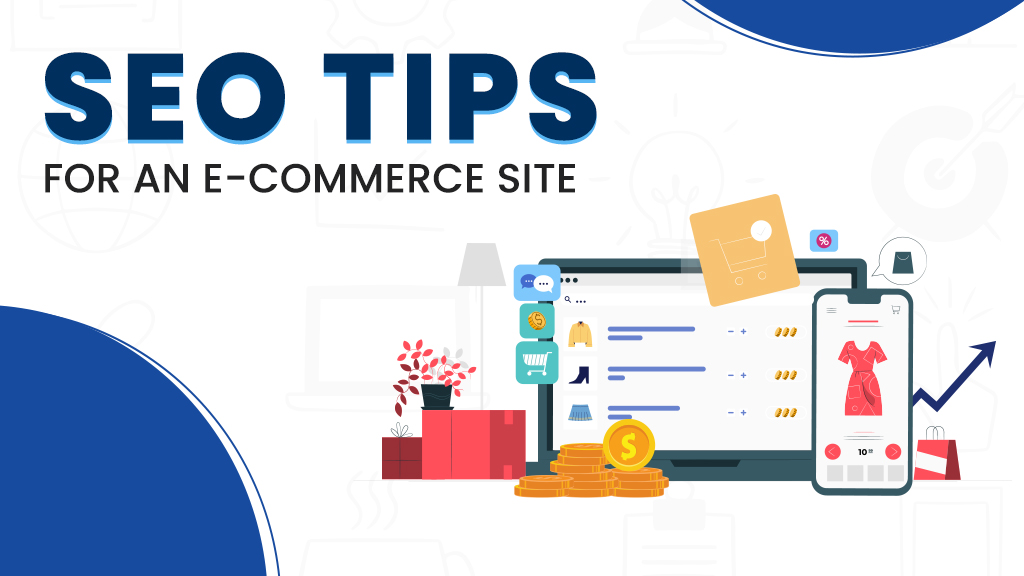Introduction to E-commerce SEO
Running an e-commerce site is like competing in a big race. To get noticed, you need SEO (Search Engine Optimization). SEO helps boost your website’s visibility on search engines like Google. It draws in more visitors and potential buyers. For e-commerce, strong SEO means better rankings, more clicks, and more sales.
In this guide, we’ll explore the key SEO tips for e-commerce businesses should follow.
Keyword Research for E-commerce
Before improving your site, you need to discover the right keywords. Keywords are the words people use when searching for products like yours. Focus on buyer-intent keywords, which show someone’s interest in buying. Tools like Google Keyword Planner or Ahrefs help find these keywords. Long-tail keywords (more specific phrases) work even better. For example, instead of “shoes,” try targeting “blue running shoes for men.” Use these keywords across your site—especially in product descriptions, titles, and metadata.
Optimizing Product Pages
Product pages are crucial for SEO. Write unique descriptions for each product. Avoid copying the manufacturer’s descriptions because this creates duplicate content. Sprinkle relevant keywords naturally, but don’t overuse them. Add high-quality images and use alt text for them. The alt text should describe the image and include keywords where it fits. Also, optimize URLs. Instead of a generic URL like “example.com/product123,” try “example.com/blue-running-shoes.” Clear, keyword-rich URLs help users and search engines understand your product.
Site Architecture and Navigation
A clear site structure makes your site easy to explore. Logically arrange your categories, and keep every page within three clicks from the homepage. Use breadcrumbs to help users see where they are and go back easily. Also, create and submit an XML sitemap to search engines so they can crawl and index your pages better.
Technical SEO for E-commerce
Technical SEO takes care of the backend of your site. Make sure your ecommerce website loads quickly. Compress images and tidy up code to make it faster. Slow websites annoy users and cause them to leave. A mobile-friendly site is also vital because many people shop on mobile devices. Secure your site with HTTPS, which Google prefers, and it builds trust with your customers.
On-Page SEO Best Practices
On-page SEO means optimizing each page of your website. Create strong title tags and meta descriptions—this is what users see in search results. Include your main keywords and make them appealing. Use internal links to connect related pages on your site. This keeps visitors browsing and helps search engines understand your content. Add schema markup, which is structured data that makes your pages eligible for rich snippets (like product ratings) in search results.
Content Strategy and Blogging
Blogging is a smart way to improve SEO. Write content that answers questions your potential customers have. For instance, if you sell fitness gear, create a blog about “How to Choose the Right Running Shoes.” This type of content attracts people before they decide to buy. Update your blog with buying guides, tips, and customer reviews. Fresh content shows search engines that your site is active and relevant.
Link Building for E-commerce
Backlinks—links from other sites to yours—are important for SEO. They tell search engines that your site is trustworthy. You can earn backlinks by writing guest posts on other blogs, working with influencers, or getting mentioned in news articles. Focus on getting links from reputable, related websites. Use tools like Ahrefs or Moz to track your backlinks and ensure they come from good sources.
Local SEO for E-commerce
Local SEO matters if your e-commerce site has physical stores. Start by setting up a Google My Business (GMB) profile and add accurate details like hours, address, and phone number. Use location-based keywords in your content. For example, if you sell handmade soaps in Seattle, optimize for “handmade soaps in Seattle.” Build local citations by listing your business in local directories. If you have multiple store locations, make landing pages for each.
Tracking and Analyzing SEO Performance
To know if your SEO efforts work, you need to track performance. Use Google Analytics to check traffic, bounce rates, and sales. Google Search Console shows which keywords bring traffic and where your site ranks. Regularly review these metrics to spot trends and adjust your strategy. If a product page has a high bounce rate, it might need better content or a faster load time.
User Experience (UX) and SEO Alignment
SEO and UX work together. If your site is hard to use, people will leave, and your rankings will drop. Make your site easy to use, with clear menus, simple checkout steps, and visible calls to action (CTAs). Focus on creating a smooth, user-friendly experience. The longer people stay on your site, the more likely they are to buy, and Google will see this as a positive ranking signal.
Implementing Reviews and User-Generated Content (UGC)
Encourage your customers to write reviews. Reviews build trust and also help with SEO. They create fresh content with natural keywords. Use schema markup to show star ratings in search results, which can increase clicks. User-generated content, like customer photos or comments, adds valuable content for search engines.
Page Speed Optimization
Page speed is important for rankings. Use tools like Google PageSpeed Insights to check your load times. Compress images and reduce unnecessary code to improve loading speed. If pages take too long to load, visitors will leave. Faster pages also tend to convert better, which means more sales.
Top E-commerce Platforms to Build Your Online Store
Shopify

Shopify ranks as one of the top platforms for building e-commerce websites. It shines for its simplicity, especially for beginners, and packs a wide range of features.
- Ease of Use: Shopify’s drag-and-drop setup lets you design a store without needing any coding knowledge.
- Customization: Shopify offers a large gallery of themes, both free and paid, allowing you to tailor your site.
- Payment Options: Shopify supports various payment systems, like Shopify Payments, PayPal, and Stripe.
- Scalability: Shopify suits small businesses as well as big companies. Shopify Plus offers extra features for high-volume stores.
- App Store: Shopify’s app marketplace brims with tools for marketing, shipping, inventory, and more.
WooCommerce

WooCommerce serves as a powerful plugin for WordPress, offering great flexibility for people already familiar with WordPress.
- Flexibility: Since it connects with WordPress, WooCommerce allows limitless customization through themes and plugins.
- Control: WooCommerce gives you complete control over your store, from design to function, but you need some technical skills.
- Payment Options: WooCommerce integrates with multiple payment systems, like PayPal, Stripe, and bank transfers.
- SEO: WooCommerce runs on WordPress, which ranks well for SEO, making it excellent for driving organic traffic.
- Hosting: You must choose a hosting provider, and costs depend on your provider and site traffic.
Magento

Magento, now part of Adobe, delivers immense power and flexibility for building large e-commerce stores. It’s a perfect fit for those who possess technical knowledge.
- Customization: Magento grants you deep customization options, allowing you to shape your store to meet your needs.
- Scalability: Magento works well for businesses with large catalogues or complex needs.
- Open Source: Magento has a free, open-source version, but most prefer Magento Commerce (Adobe Commerce) for advanced features.
- Payment Options: Magento supports various payment methods and offers many integrations.
- Technical Skills: You’ll need good web development knowledge or help from a developer to manage Magento.
Wix eCommerce

Wix offers a simple platform for building e-commerce stores, making it ideal for beginners. It’s designed for smaller to medium-sized shops.
- Ease of Use: Wix provides an easy drag-and-drop builder that helps you create a store without writing code.
- Design: Wix offers modern, responsive templates that you can tweak to fit your brand’s style.
- Payment Options: Wix integrates with many payment systems like PayPal, Stripe, and Square.
- App Market: Wix has an app market filled with tools to boost the functionality of your online store.
- SEO: Wix has basic SEO tools, though not as advanced as WooCommerce or Shopify.
Squarespace

Squarespace, known for its elegant designs, helps businesses create professional-looking e-commerce websites quickly. It stands out for its clean design and easy use.
- Design: Squarespace showcases beautifully designed templates, making it ideal for creative businesses or those focused on branding.
- Ease of Use: Squarespace features an easy website builder that requires no coding, allowing quick and smooth setup.
- Payment Options: Squarespace supports Stripe and PayPal for payments.
- Built-in Features: Unlike other platforms, Squarespace includes many features (e.g., SEO tools, analytics, and email marketing) without needing extra apps.
- SEO: Squarespace offers good SEO tools but doesn’t have as much flexibility as WooCommerce or Magento.
Each platform provides unique advantages. The best platform depends on your technical knowledge, budget, and the size of your store.
Conclusion
SEO is not a one-time task—it needs ongoing effort. By following these ecommerce website seo tips, you’ll boost your site’s visibility, draw in more visitors, and increase your sales. Focus on optimizing product pages, improving site speed, and updating content regularly. Stay flexible and adapt as SEO trends change. SEO is a long-term investment, so keep working on it, and you will see results.




